Mexican Centenario Gold Coins

 Mexican 50 Peso gold coins - the predecessors of the Mexican Gold Libertads
Mexican 50 Peso gold coins - the predecessors of the Mexican Gold Libertads
The design of the historic Mexican Centenario gold coins that are featured on this page was the inspiration for the design of the contemporary Mexican Gold Libertad coins. The Gold Centenarios were minted by the Casa de Moneda de México between 1921 and 1947. The coins were named Centenario because they are dedicated to the 100th anniversary of Mexico gaining its independence from Spain, its former colonial master. Due to their face value of 50 Pesos, the coins are also commonly referred to as Mexican 50 Peso gold coins. The Mexican Centenarios were however never intended to be used as currency.
Just like the 'Azteca' Mexican 20 Peso gold coins and the Mexican Gold Hidalgos, all Mexican Gold Centenarios are composed of 90% gold and 10% copper. With an unusual actual gold weight of 1.2057 oz, the Centenarios still are the largest and heaviest of all gold coins that were minted in Mexico. Their obverse side shows Mexico's Angel of Independence with a laurel wreath and broken chains. Mexico's coat of arms can be seen on the reverse. It shows an eagle perched on top of a prickly pear cactus holding a serpent. This image appears on other Mexican gold coins as well.
With a total mintage that exceeded 8.5 million, Mexican Gold Centenario coins aren't rare gold coins. You won't find them as commonly listed for sale online as other gold coins though. If you buy gold in the form of these coins, you should be aware that many modern restrikes of the Gold Centenario were made, sometimes with historic dates! American buyers that are investing in gold for their retirement should take note that the Mexican Centenario gold coins are not eligible for inclusion in Individual Retirement Accounts (IRA's) since they are classified as collectible gold coins by the IRS.
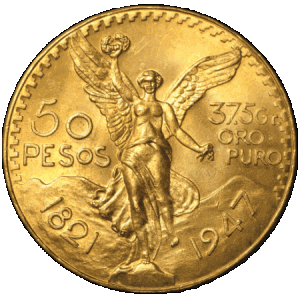
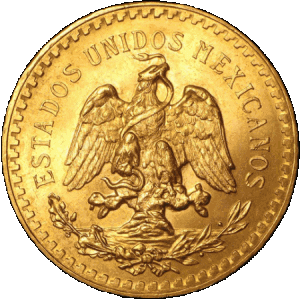
Coin Fact Sheet
| Weight | Face Value | Purity | Diameter x Thickness |
|---|---|---|---|
| 1.2057 oz | 50 Peso | 90% | 37.1 x 2.69 mm |
Total Mintage: 8,532,000
Design of the Mexican Centenarios
The 50 Peso gold coin was designed by Emilio del Moral and the design was later reused for the popular Gold Libertads and Silver Libertads. The obverse side of the coins depicts "El Ángel de la Independencia" (eng: The Angel of Independence) with a laurel wreath in her right hand and broken chains in her left. "El Ángel de la Independencia" (a.k.a. "Monumento a la Independencia") is a victory column in downtown Mexico City. The famous Mexican volcanoes Popocatepetl and Iztaccíhuatl are depicted in the background. The date 1821 (the year of Mexico’s independence) and the year of mintage appear to the bottom left and right. The words "50 PESOS" and "37.5 Gr. ORO PURO" are respectively engraved above.
On the reverse side of each Mexican Gold Centenario coin you'll find a rendering of Mexico's coat of arms which shows an eagle perched on top of a prickly pear cactus while holding a serpent in its talons and beak. The words "Estados Unidos Mexicanos" are inscribed along the coin's upper edge.
History of the Gold Centenario
The 50 Peso Mexican gold coin was first issued in 1921 in commemoration of Mexico's first century of independence. That's why the coin is commonly referred to as Mexican Centenario. The Casa de Moneda de México at first issued the coins without interruption between 1921 and 1931.
High demand for gold coins resulted in production being restarted in 1943. The highest mintage numbers were reached in the years that followed but this second mintage period didn't last very long. Already in 1947, the Mexican Centenario gold coin was minted for the last time. However, restrikes of the coin were made in later years.
Coin Variations
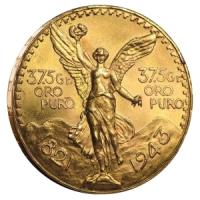
Only the coins that were minted in 1943 have the wording 37.5 Gr. Oro Puro (37.5 grams pure gold) appear to the left and the right of the angel. The usual "50 Pesos" inscription was omitted that year since the coin's actual gold value far exceeded that face value.
The coin returned to its original design the following year. The image near the top of the page shows the standard obverse design that shows both the face value and gold weight. To the left, you see an image of the obverse side of a coin from 1943 with the double-mention of the gold weight.
Restrikes of the Mexican Gold Centenario
Modern restrikes of the 50 Gold Peso Centenario were made from 1949 to 1972 (with the 1947 date !!!), from 2000 to 2009 and in 1996.
A total of 3,975,654 coins were restruck between 1949 and 1972 and an additional 302,000 coins were restruck between 2000 and 2009. The number of restrikes that were made in 1996 is unknown.
Mintage Numbers
Annual mintage of the 50 Peso Mexican Gold Centenario varied between 89,000 and 1,588,000 coins. The highest production during the first mintage period (1921 - 1931) was reached in 1925 when 716,000 Mexican 50 Peso gold coins were struck. The years 1921 (mintage of 180,000 coins) and 1931 (137,000 coins) were the years with the lowest mintage numbers during the initial mintage period.
Mintage of the coins resumed in 1943 with an all-time production low of 89,400 coins. Mintage numbers increased sharply in the following years. The highest mintage of the Mexican Gold Centenario was reached in 1946 with 1,588,000 coins.
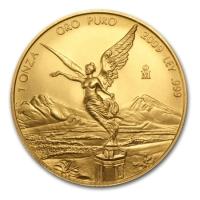
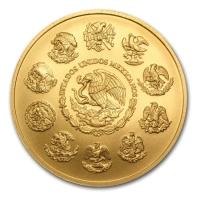
Mexican Gold Libertads
The Mexican Gold Libertad coins are struck out of 99.9% pure gold since 1981. Their design that depicts the Angel of Independence is inspired by the historic Mexican Centenario gold coins. The Gold Libertads are minted by the Casa de Moneda de México, the oldest mint in North America, in the denominations of 1 oz, 1/2 oz, 1/4 oz, 1/10 oz and 1/20 oz. Both brilliant uncirculated and proof coins are available. The coins don't have an official face value and their annual mintage numbers are much lower than those of other gold bullion coins. Despite that, the coins have legal tender status in Mexico.
The Mexican Gold Libertad page gives more information about the coins and allows you to compare current prices.